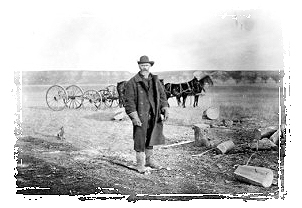
John Glenn
Calgary's first European Settler
John Glenn was Calgary's first European settler, a good man, fine neighbour and a great citizen of Calgary. These pages and documents attempt to tell John Glenn's story. Documents relating to John Glenn can be found at the links provided at the bottom of this page.
"Live within your means and save a beet for a rainy day"
John Glenn was born in 1834 in Mayo County, Ireland. As a young man, he left his native hearth to seek his fortune in England. Homesick, he returned to Ireland with the intention of visiting his home but, when within a few miles of his father's farm, changed his mind and re-crossed the Irish Sea to Liverpool, England. From there, at the age of 16 years, he emigrated to New York, U.S.A.
Travelling west, he obtained employment on a ranch near Waco, Texas. In 1862 he was drafted into the Confederate Army. Opposed to slavery, he deserted and joined the Northern Federal Army, serving under General William Techumseh Sherman until the end of the American Civil War in 1865.
Following the war he journeyed around the central and western states, working in mines and in 1867, moved on to British Columbia and then panned for gold in Barkerville along with James Votier and Sam Livingston, men who were, in later years, to become his neighbours in the Calgary district.
When searching for gold, struggling over the Yellowhead Pass, he met the Sanford Flemming expedition heading for Kamloops in their survey for a suitable right of way for the C.P.R.. In Grant's book "Ocean to Ocean", there is a description of this encounter; "Two miles from the "red Pyramid" that looked so kindly and touched a chord in our hearts, the sound of a bell was heard. Jack said it must be the bell horse for another pack train but in a few minutes a solitary traveller, walking beside his two laden horses, emerged from the woods ahead. He turned out to be John Glenn - a miner on his way to prospect for gold on hitherto untried mountains and sand bars. He was a specimen of Anglo-Saxon self reliant individualism, more striking than that pictured by Quinet of the American Settler, without priest or captain at his head, going out in the deep woods or virgin lands of the new continent to find and found a home. John Glenn calculated that there was as good gold in the mountains as had yet come out of them and that he might strike a new bar or gulch that would 'pan out' as richly as 'William Creels' in the Caribou; so putting blankets and bacon, flour, and frying pan, shining pick-axe and shovel, on his horses and, sticking revolver and knife in his waist, off he started from Kamloops to seek "fresh fields and pastures new". Nothing to him was lack of company or of newspapers; short days and approach of winter; seas of mountains and grassless valleys, equally inhospitable, risk of sickness and certainty of storms - slow and exhausting travel through marsh and muskeg, across raging mountain torrents and miles of fallen timber; lonely days and lonely nights; - if he found gold he would be repaid. Prospecting was his business and he went about it in a simple, matter-of-course, style as if he were doing business 'on change'. John Glenn was, to us, a typical man, the modern missionary, the martyr for gold, the advance guard of the army of material progress and who will deny or make light of his virtue, his faith, such as it was? His self-reliance surely, was sublime. Compared to his, how small the daring and pluck of even John Milton and Cheadle? God save thee, John Glenn! and give thee thy reward."
John also carried a letter from the Hudson's Bay Company agent at Kamloops telling the Flemming party that their personal baggage had arrived from Toronto via San Francisco and was waiting for them.
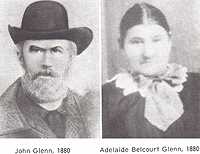
After years of solitary wandering the forty year old bachelor decided, in 1873, that it was time to settle down so married Adelaide Belcourt of Lac St. Anne in a ceremony performed in the mission, (built by Father Lacombe at St. Albert, twenty years previously) by Reverend Father Leduc.
With two horses and a mule, they started south to find suitable land on which to settle. Impressed by the fertile soil in the broad valley where fish creek flows in to the Bow, the newlyweds decided this was the spot for their future home.
They built a log cabin complete with sod roof, stone fireplace and chimney. Here, in 1873-74 they wintered and thus became the first settlers in the Calgary (Midnapore) area. Later he said; "I like the climate better than any I have found between the Atlantic and the Pacific; the Rio Grande and the Peace, over all of which territory I have travelled. There is everything in the country a settler can desire."
Adelaide Glenn (née Belcourt) was a Métis woman from Lac Ste. Anne. She was no less a pioneer than her husband, raising six children (two other children died in infancy), tending livestock, and providing room and board for travellers. She also provided vital emotional support to the early women settlers who arrived shortly after her pioneering settlement. Her services as a midwife earned her the nickname of the "Grandmother of Midnapore".
They, our parents, stayed there till the spring of 1874. At that time an uncle of Mother's was going north from Montana. Mother, not being well, Father decided to send her home to her parents at Lac Ste. Anne and he continued off to Sun River, Montana, headquarters for the I.G. Baker Company. There he bought a wagon and one mule, giving him a team of two horses and two mules; he took a full load of trade goods; tea, flour, sugar and tobacco, to trade with Indians, taking furs, buffalo hides and pemmican in pay. He arrived back at Lac Ste. Anne in June, having disposed of all trade goods. Patrick Glenn Was born on June 3, 1874. They now proceeded south again, stopping at Fish Creek for a few days, they continued on to Sun River, where he sold all his furs, etc.
They bought another team of four horses and harness and a wagon. With two full wagon loads of all kinds of provisions, they started back toward Fish Creek, where they intended to trade off all their goods to the Indians. Somewhere, south of Lethbridge, they met a group of N.W.M.P. under the command of Colonel Macleod, October, 1874, and guided them into, what was soon to be, Fort Macleod. There they sold all of their provisions to Colonel Macleod.
Mother stayed with Mrs. Macleod and Father helped to build the Fort as well as all the stone chimneys and fireplaces. In the spring of 1875 they went back south, this time to Fort Benton, and bought two full loads of goods, including stove, windows, hardware, all for a new, permanent home they were intending to build. At that time there was no Macleod Trail. The only road used to be west, in the hills, via the old Mission and Morley, where the MacDougall's had a trading post and mission. On July 3, 1875, Johnny Glenn was born at Sheep Creek. Three days later they arrived at the old Mission on the Elbow River. This is where Mother first met Mrs. Sam Livingston. Livingston's had built their cabin there in 1874. After several days of rest, they continued down the Elbow to where Calgary was later established and on down to Fish Creek. This would be about mid July, 1875. In September, Mother went back to the old Mission and stayed with Mrs. Livingston. Later, when the Livingston's located at Fish Creek, Father helped them build their first home.
Each of the next three years, he made one, and sometimes two , trips to Fort Benton. In these years he had a crew of men. In charge of Mr. Bearer, a French half-breed, they erected a large dwelling, barn and other buildings (completed about 1878 or 79) which became an established stopping place, meals 50 cents and everyone carried his own bed. At this time he started raising cattle and broke some of the virgin sod to grow grain. The land was not irrigated except for natural flooding but the soil was fertile and the crops flourished. Three years later the farm consisted of nine, partially fenced, acres sown to oats and barley, a hay meadow and a vegetable garden.
John Glenn did not remain there. In 1879 Edgar Dewdney, Commissioner of Indian Affairs in the North West Territories, sent Thomas Wright to select a suitable site for an Indian Supply Farm, in the Morleyville area. While in the Calgary district, on other business, Dewdney, after inspecting the Glenn holdings, considered Fish Creek Valley ideal for the project and sent for Wright to join him there.
In his report of 1879 the Commissioner, wrote; "after spending a couple of days looking for a location, I found at the mouth of Fish Creek, at its junction with the Bow River, a beautiful site for a farm.
A man, of the name of Glenn, had a small crop of barley and oats - 41/2 acres of each - partially fenced and with enough rails to complete it, two small cabins about the same size and which will make a good storehouse, with large root house adjoining, and a small stock of hay.
I thought it necessary to get rid of him before making up my mind to locate there, and as soon as Mr. Wright returned from Morleyville took him down to see the place and get his idea of it, as well as to put a value on the improvements that had been made by Glenn. Mr. Wright was enchanted with the place. The barley he considered the finest piece of grain he had ever seen grown. It was about three feet high and as level as a billiard table, and he estimated there would be fifty bushels to the acre. The oats were also very fine, the cabins he estimated at $50.00 each and the crops he thought would turn out - barley 9,600 lbs, ; oats 6,800 lbs.
I saw Glenn and asked him what he would take for the improvements. He valued the whole thing at $350.00.
I endeavored to induce him to throw in a milch cow and calf but he refused, and I closed giving him $360.00 for his improvements and the cow and calf. The Department took possession on August 1, 1879."
Thus Glenn's first property became Indian Supply Farm Number 24.
Having sold the farm, John Glenn moved "up the creek" to settle on land legally described as SW 1/4-3-23-1-W5. Here he set up his farmstead near the south banks of Fish Creek about a stone's throw east of the Macleod Trail.
The Marquis of Lorne, then Governor General of Canada, wrote in his book, "Memoirs and Travels of the Marquis of Lorne":
"John Glenn, not being accustomed to royalty and nobility, said to the Marquis "I don't know what they call you but you shall be called 'mister' here" and he states that from then on he was known, in the Territories, as Mr. Lorne.
After moving to what would be his last home in 1879, John Glenn started, if he did not complete, the construction of his historic irrigation system, nineteen years before the Alberta Irrigation Company started their first project near Lethbridge. Glenn erected an earth and rock dam about one half mile west of the Macleod Trail and with 2" x 4"s, sixteen feet long, diverted the water from the creek into a ditch which carried the water to irrigate his fields east of the Trail.
A sketch of general details in connection with the irrigation ditch constructed by the Glenn Estate, approved and certified by the chief Inspector of Survey, J.S. Dennis, on October 3, 1895, shows the dam to be 80' long; constructed of gravel and boulders, in the shape of an equilateral triangle, 6' at the base; the head gate was two feet wide, manually activated, the fluming under the Calgary Macleod Railroad right of way as 5' 6" wide, 2' high, constructed of 2" x 4"s, 49' long' and the 14' bridge across the ditch was made from 3" planking nailed to five, 3" x 8" stringers.
The system was built without the benefit of legal status, the first Irrigation Act didn't come into force until 1893, some fourteen years later. When the railroad (now C.P.R.) was built from Calgary to Fort Macleod in 1891, this company recognized the prior right established by Glenn, by installing a box culvert under its grade, 650' south of its bridge on Fish Creek. This culvert was relocated September, 1958 when an iron pin nearly 20" long and 3/4" thick, was found at the east end. The pin, hand made, with a carefully belevelled head and a chiselled point, likely served some engineering purpose, either to fix the elevation or the location of the culvert. It should be added this pin provides the only available artifact of the John Glenn irrigation project.
The area actually irrigated by Glenn has been variously given as from 20 to 40 acres, while the Government report published in 1895 states 130 acres could have been irrigated. The irrigation works served to supply water for his nearest neighbour, Samuel William Shaw, who arrived from England in 1883 and settled west of the Macleod Trail on Fish Creek, next to Glenn's farm. The supply ditch cut through the Shaw quarter and for a number of years about 6 acres of land was irrigated from the Glenn project. Therefore it was also the first neighbour irrigation system built and used on the Canadian prairies. The project also supplied water for the woollen mills operated by the Shaw's.
According to eye witnesses, the diversion works were partly washed out by a heavy flood in 1885 when the course of the creek was changed. Despite this, the system continued to operate; the Shaw's continued to use the water until 1902 when the diversion works were completely destroyed and were never rebuilt.
From affidavits in support of application for homestead (No. 100149 dated August 10, 1885), we learn that John Glenn had fenced 200 acres, was farming 90 acres, had built a house 26' 20' with an addition of 28' x 15', of logs and outbuildings, including a stable 80' x 40' and a store house 20' x 20' with an addition of 28' x 15' of logs and outbuildings, including a stable 80' x 40' and a store house 20' x 20'. His patent (title of land) was issued by the Department of the Interior on January 3, 1886 and sent to him on March 31 of the same year.
His interest extended beyond farming, as evidenced by his lively participation in community affairs. He possessed a high degree of business ability and according to one neighbour also possessed the spirit of prophecy. He was one of 30 pioneers who attended the first sale of lots in section 15, and in fact purchased the first piece of land, in what was to become the City of Calgary. Later, a report published in the Calgary Herald Mining and Ranch review, March 26, 1884 listed that Glenn had three buildings under construction, on 25' x 45', one 25' x 68' and one 120' x 48'. The 1887 Town of Calgary Tax Roll revealed that the real value of the John Glenn estate was $2600.00. He had erected the largest livery stable (Frontier) and two of the largest business buildings. In 1884 he donated two acres of land to the Anglican Church who, with the aid of Queen Anne's Bounty (which went to raise churches in the far-flung corners of the Empire), built St. Paul's Anglican Church, Midnapore. His name is to be found on subscription lists supporting any worthy cause.
Adelaide and John were blessed with eight children, Patrick, John, Alfred, William, Edward, Margaret, Eliza and Mathilde, (Eliza and Mathilde both died in childhood). As there were no schools in the area, Patrick and John were educated at St. Boniface school in Winnipeg. Margaret (Maggie died while a young girl) and the three younger boys went to James Shortt school and later, St. Mary's school in Calgary. Patrick was the only one of the six to marry. His wife was Filomena Hodgson, daughter of George Hodgson, Indian Agent at Sarcee Indian reserve.
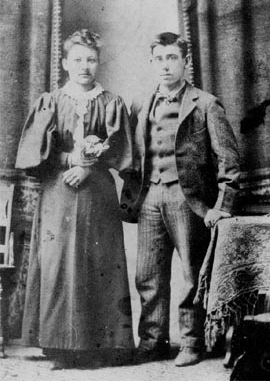 Patrick
and Filomena had six children; Dorothy
Violet (Darling) who
lived in Seattle, Washington and had three daughters and a son who died in
infancy; Kathleen Cecelia (Ships), no children; Victoria Filomena (died in
infancy), Matilda Lucy (Stage), no children;
Marion Frances
(Marshall), Calgary, who had two boys and three girls, and Edmund Patrick.
Patrick
and Filomena had six children; Dorothy
Violet (Darling) who
lived in Seattle, Washington and had three daughters and a son who died in
infancy; Kathleen Cecelia (Ships), no children; Victoria Filomena (died in
infancy), Matilda Lucy (Stage), no children;
Marion Frances
(Marshall), Calgary, who had two boys and three girls, and Edmund Patrick.

Very little about Adelaide Glenn has been recorded for posterity. It is safe to say that she complemented her husband by looking after the home in a manner associated with the responsibilities of a pioneer woman. In addition to her household duties and attending to the comfort of their many guests, she mothered six children in ten years. Frances (Glenn) Marshall remembers her grandmother driving to Calgary for supplies; how she went swimming with her grandchildren and how she derived special pleasure from berry picking and going fishing. She also told how her grandmother delivered all but one of the McKevitt children and that she was called to be mid-wife for Mrs. James Lougheed. She also took unusual interest in the well-being of her grandchildren and was "Granny" to all and sundry children that came to the home.
Regrettably, the story of John Glenn has an unfortunate ending. It is unclear what happened in late December of 1885, shortly after the Riel Rebellion. One story goes that John Glenn's horses may have been spooked, which resulted in him being thrown from his wagon, which resulted in injury (this is the story reported in the Calgary Herald). Another story goes that he and one of his drivers had a difference of opinion which resulted in a fist fight. This story was related by an old time resident of Midnapore. "His driver was a man named Bill Smith and an argument arose between the two men over some matter concerning the horses and the men engaged in a fight. Glenn was badly beaten and left unconscious on the side of the road near Calgary. A passer-by found him and took him home". Regardless of which is true, He never fully recovered and died of pneumonia on January 9th 1886. John Glenn is buried in the pioneer section of St. Mary's Cemetery in Calgary.
He was an astute business man, a good neighbour and interested in the progress of development in the City of Calgary as well as the farmland to the south.
After a full and satisfying life, Adelaide died of pneumonia in her 88th year.
The Glennfield area of Fish Creek Park in Calgary is named in memory of John and Adelaide Glenn.
John and Adelaide Glenn's cabin
was dismantled in 1999 for an archeology study by the University of Calgary, to
date it has not been rebuilt.

Views looking out from and at original Glenn house at Fish Creek, prior to being dismantled by the archeology department of the U of C in 1999. The plan was to rebuild the house once excavation was complete, however this has not been done and funds have not been made available.
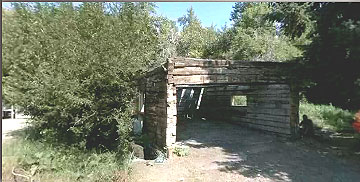
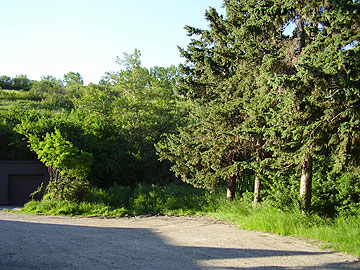
The site of the original house as it is now.
The Calgary Herald's remembrance of John Glenn 1886
Click here to read a news article published in the Calgary Herald in 1955, about John Glenn
Father Constantine Scollen - portion of his fonds, story about John Glenn
Letter from John Glenn to the Editor of the Calgary Herald, April 9th, 1885
Calgary's first land sale, excerpt from an article by Tom Ward, 1977